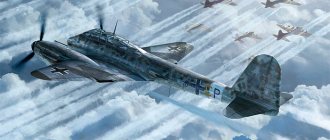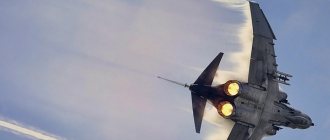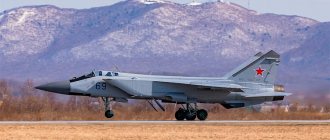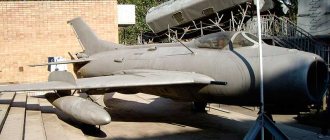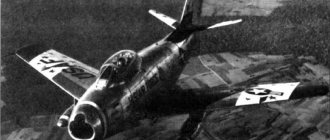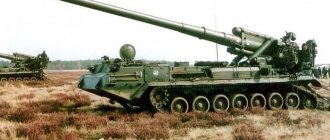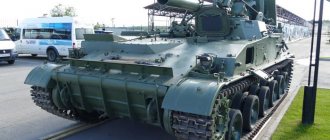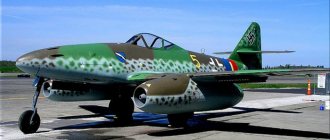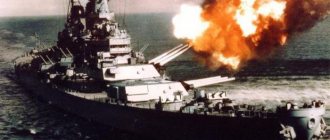It is impossible to imagine the Second World War without air battles. Leading world powers tried to gain air supremacy over the battlefield or over the territory of their enemy. The main role in this was given to fighters.
Although they were not the main weapon of the Air Force, air cover was necessary to ensure the safe operation of bombers and attack aircraft. The most popular fighter in the world air force was the Messerschmitt Bf.109, produced in various modifications in more than 34 thousand copies.
What was the history of creation
One of the consequences of Germany's defeat in the First World War was a complete ban on the development and creation of military aircraft. The situation changed with the coming to power of the Weimar Republic, the NSDAP, led by Adolf Hitler.
The new government immediately set a course for the militarization of the country. One of the leaders of the party was the hero pilot of the First World War, Hermann Goering. He headed the Ministry of Aviation formed in 1933.
The minister zealously took up the assigned task and already in 1934 a competition was announced among aircraft manufacturers to create a fighter with a speed of at least 450 km/h.
The aircraft being designed were to be single-seat monoplanes designed to replace the obsolete Heinkel 51 and Arado 68 biplanes.
The companies Heinkel, Focke-Wulf and Arado were invited to participate in the competition. Messerschmitt's company was not invited due to lack of experience in designing high-speed combat aircraft.
In the same year, the company Bayerische Flugzeugwerke (Bf) (can be translated into Russian as Bavarian Aircraft Factories) began to develop an aircraft with similar characteristics for the Royal Romanian Air Force.
When news of this development reached the government, a huge scandal broke out, as a result of which Willy Messerschmitt’s company was allowed to participate in the competition.
On May 28, 1935, the first Messerschmitt Bf.109 took to the skies, and it was equipped with an English engine.
In the production of aircraft engines, Germany at that time was far from the leading world powers.
The selection committee did not identify a winner among the aircraft submitted to the competition. The main struggle was between the Messerschmitt and Heinkel firms. Despite the fact that the maximum speed of the Bf.109 was 17 km/h higher than its competitor, it was cheaper and easier to control, no final decision was made.
Luftwaffe employees leaned towards the Heinkel He-112. I would especially like to note that this point of view was held by the famous pilot Ernst Udet, who over time radically changed his views.
Since the commission was unable to decide on the winner, competitors pre-ordered 10 aircraft from each company. The Spanish Civil War, which began in 1936, became an excellent testing ground for military equipment from many countries around the world.
Pilots of the German Condor Legion, formed in 1935 by the Luftwaffe (air force), participated in General Franco’s troops. Combat use showed a clear advantage of the Messerschmitt design, which was put into service in 1937.
Flight safety
In the air, the Messerschmitts were quite reliable. True, early modifications of the DB 605 engine had a certain tendency to self-ignite, but then this problem was solved. At the same time, the Bf.109 was a dangerous aircraft for the pilot during takeoff and landing. The reason is poor chassis design. The too narrow track of the main struts and the low landing of the rear wheel often led to accidents and disasters. Novice pilots found themselves in the most vulnerable position.
One of the typical results of an unsuccessful landing is a broken landing gear. Much more serious accidents have happened
The most “emergency” modification was the Bf.109G modification. Up to one third of these aircraft crashed during landing or takeoff. This did not always, of course, lead to the death of the pilot, and the plane could often be repaired, but this situation had an extremely negative effect on the level of combat readiness.
What was the design of the aircraft?
In the mid-30s of the last century, there was a transition in the military aircraft industry from biplanes with air-cooled engines to monoplanes with liquid-cooled engines. This transition was justified by the sharply increasing speed of the aircraft, which made it possible to more quickly carry out combat missions.
The Messerschmitt Bf.109 that appeared fully met the requirements of our time.
It was a monoplane with a trapezoidal wing at the bottom of the fuselage, with a liquid-cooled engine.
The plane itself was all-metal, with an engine located in the forward fuselage. In its central part there was a closed cockpit, with transparent plexiglass glazing, providing the pilot with good viewing conditions forward and to the sides; rearward visibility was practically absent due to the garrot and the tail of the machine interfering with the view.
Navigation equipment and an aircraft control system were installed in the cockpit. Almost all aircraft were equipped with oxygen devices and radio stations. The latest modifications were equipped with a FuG 25A “friend or foe” recognition system, which independently sent a response signal to a ground radio station.
Two fuel tanks with a total volume of 400 liters were located under the pilot’s seat and behind his cockpit. It is worth noting that it was possible to use drop-shaped drop-shaped drop-shaped fuel tanks - PTB, located under the fuselage.
The landing gear was attached to the fuselage and retracted into special, not completely closed niches located in the wing.
Because of this design feature, the chassis track was narrow, which caused certain difficulties when taxiing.
The chassis was retracted by hydraulic drive, the wheels were equipped with hydraulic brakes. The location of the landing gear, therefore, was explained by the convenience of repairing the aircraft; replacing the wing console required little time. But at the same time, the narrow track of the chassis led to a high accident rate of the fighter.
The original highlight of the Messerschmitt Bf-109 was its tail unit - due to the fact that the stabilizer, based on struts, was movable, the pilot could change its installation angle right in flight. This had a positive effect on his maneuverability. Initially, before version E, the stabilizers had struts that added rigidity to the structure, but with modification F they were removed.
The Jumo 210 engine of various versions was installed as a power plant in early modifications. Later, from the E-series, the Daimler-Benz DB601 engine, and then its various modifications, began to be used as a power plant.
The main emphasis was on increasing the engine's power, as well as equipping it with additional equipment, which also affected its power. It is worth noting the installation of a carburetor on the aircraft, which worked reliably at any position of the aircraft in the air.
Advantages and disadvantages of the aircraft
The Bf.109 received its fame well deservedly. Its advantages, especially in the first period of the war, were obvious to both German pilots and their opponents:
- High speed at all working heights;
- Excellent rate of climb. British fighters, for example, invariably lagged behind the Messerschmitt, which was gaining altitude;
- Ease of piloting during combat;
- Excellent vertical maneuver characteristics.
Inside the cockpit of the Bf.109 fighter it was quite cramped.
The Bf.109 also had a lot of shortcomings, however, some of them did not appear immediately:
- Poor chassis design, which negatively affects both operational safety and aerodynamics;
- Poor visibility back - German pilots often did not notice the enemy attacking them from the tail;
- Poor controllability at high speed, especially during a dive. The disadvantage was due to the wing design, which did not allow the installation of more massive ailerons and spoilers, and the available surfaces were “not enough”;
- Weak weapons. At the beginning of the war it was quite sufficient, but in 1944-45 it became very difficult for Messerschmitt to fight against huge American “flying fortresses”.
Another significant disadvantage was the obvious overabundance of modifications, submodifications and various additional variants of the fighter. This caused confusion both during the production of the aircraft and when equipping troops with it.
What weapons did the plane have?
As the main armament, the first modifications of the Messerschmitt Bf.109 initially had three, and later four, 7.92 mm machine guns. The location of the machine guns was as follows:
- two synchronized MG-17 machine guns above the engine;
- a pair of MG-17s in consoles, outside the propeller sweep area.
The Messerschmitt Bf.109E aircraft received cannon armament - a twenty-millimeter MG/FF cannon was installed on each of the wing consoles. Two synchronized MG machine guns of 7.92 mm caliber were installed in the fuselage.
Wing guns were not installed; instead, the MG-151/15 or 151/20 motor gun was installed on later modifications. The body of the gun was installed in the camber of the engine cylinders, the barrel came out through the propeller shaft.
As additional weapons, the Friedrich received suspended gondolas with 15-20 mm caliber air cannons. The presence of such equipment was indicated in the aircraft brand by an added letter with a digital designation.
The letter “R” indicated that fairings with air cannons of a field modification kit were mounted on the aircraft consoles, the number indicated the type of kit: an outboard tank, a beam holder, photographic equipment or outboard guns.
The most common aircraft model was the Messerschmitt Bf.109G.
The firepower of the aircraft was further enhanced; instead of standard German MG machine guns of 7.92 mm caliber, it received MG-131 machine guns of 13 mm caliber.
On the Messerschmitt Bf.109G-6 aircraft, a 30 millimeter MK-108 cannon was installed in the engine camber. To eliminate a fighter with one engine, one hit was enough; a twin-engine fighter was destroyed by being hit by 5-6 shells.
In 1943, the Messerschmitt Bf.109G-6 acquired missile armament - one launch tube was installed on each of the wing consoles. The missile had a mass of 40.8 kilograms, guidance was carried out by a mirror sight, and stabilization in the air was due to rotation. The effective range was 1200 meters, which exceeded the possibility of being hit by cannon or machine gun fire.
The development of aviation missile weapons at that time did not allow targeted shots to be fired at single aircraft, so missiles were used to destroy American and British bombers flying in a dense mass.
Spanish Civil War 1936-39. Bf 109B.
0
The debut of the Bf 109B, and the debut is quite good. As we are used to hearing or reading, compared to all the other aircraft that the countries that fought in Spain (Italy, Germany, the USSR) had, the Bf 109 looked head and shoulders above everyone else. That is why in many countries designers believed in the triumph of the water-cooled engine over the air vent.
×
0
And here is the first such surprise. It is in the table that shows the performance characteristics of the aircraft that took part in that war. What do we see? And we see a very strange picture. Well, if you believe the numbers, the Bf 109B doesn’t shine. Doesn't shine at all. It is the heaviest, with an unimportant rate of climb compared to biplanes, since the engine was also not very strong. And the weapons were not brilliant. Of course, three MG-17s are much better than four PV-1s, which is very much a Maxim, but air-cooled. But clearly worse than two ShKAS and even more so two large-caliber Italian machine guns. Yes, the speed was better. This is the only thing that made the Bf 109B stand out. By the way, the Bf 109C model, which was equipped with a more powerful (20 hp) engine, became heavier (200 kg) with all that it implies. Plus there were four machine guns: two synchronized and two wing-mounted. In everything else, well, everything is more than doubtful. Yes, according to our history, everything was like this: our people in Spain tore everyone apart until the “miracle weapon” came in the form of the Bf 109B and defeated everyone. If you look at the numbers, surprise begins. And you realize that somewhere everything is very strange. Either in these numbers (I definitely believe them), or in memoirs.
0
I think that the truth is in the middle and lies in the human factor. But more on that at the very end. Those who fought in the Condor Legion were not aviation school graduates at all. There, maturing wolves sat in the cabins, and even if they lacked combat experience, they went to Spain for him. Instead with colleagues from Italy and the Soviet Union. And there was experience there - rowing with a shovel. And rowed. But in general the situation is more than funny, I wonder what those who read the article line by line will say. But we move on.
Modifications of the Messerschmitt Bf.109 aircraft and their performance characteristics
Messerschmitt Bf.109A researchers still cannot come to a consensus on whether this version of the aircraft existed in principle. Some experts believe that 20 copies of this modification were produced, others believe that the index “A” was used to refer to the first three prototypes.
- Messerschmitt Bf.109B. The army nickname is Bruno, however, some sources indicate Bertha. The first serial modification, production began in 1937 in Augsburg. It had a Jumo 210 engine with a power of 680 hp. and a speed at an altitude of 422 kilometers per hour. The armament consisted of three, later four MG 17 machine guns of 7.92 mm caliber.
- Messerschmitt Bf.109C. There are also discrepancies regarding the nickname - the most popular option is Caesar, but Clara has also been encountered. The power plant was an improved Jumo 210A engine, equipped with a fuel injection system and 700 hp. Thanks to the increase in power, the speed at altitude increased to 468 kilometers per hour. The series was launched at the beginning of 1938. Armament: 4 MG 17 machine guns, 7.92 mm caliber.
- The Messerschmitt Bf.109D had the army nickname Dora. Serial launch occurred in the first half of 1938. It was planned to install a Daimler Benz 600 engine as a power plant, but in reality the industry did not produce engines, so they installed the Jumo 210D, similar to the Jumo 210A, but without a fuel injection system. The mass of the all-metal glider increased, and accordingly the speed at altitude dropped to 450 kilometers per hour. The armament did not change - 4 MG 17 caliber 7.92 millimeters, however, a number of aircraft had only 2 machine guns.
- Messerschmitt Bf.109E. It had the nickname Emil and was the first truly production aircraft. The engine was a Daimler-Benz DB 601, which performed at its best. It had 1,175 horsepower and allowed the plane to reach a speed of 560 kilometers per hour at an altitude of 4,500 meters. Since the aircraft was constantly modernized, the armament changed. The most popular for Emils was the installation of two 20 mm MG-FF guns and 2 MG-17 7.92 mm guns. In later versions, starting with the E-7, armored glass in the cockpit was 58 millimeters thick, and behind the pilot’s seat there was an armor plate of 6 millimeters.
- Messerschmitt Bf.109F Nickname Friedrich. The battle in the skies of England in 1940 made it clear that German single-engine fighters were no superior to the British Spitfires. Therefore, German designers made many different adjustments: aerodynamics were improved, the fuel tanks received a layer of rubber protection that could be tightened when a hole was punched in the tank, a more powerful engine was installed, and taxiing capabilities were improved. By the beginning of the aggression against the Soviet Union, approximately 2/3 of Germany’s fighter fleet consisted of these aircraft. The DB 601 engine with 1200 horsepower provided a speed of 575 kilometers per hour.
- Messerschmitt Bf.109G Nicknamed Gustav is the most common and successful modification of the aircraft. It was produced in various versions, in addition to the pure fighter itself - high-altitude, reconnaissance, night, fighter with the function of a light bomber. In addition to the 20 mm cannons, large-caliber 13 mm machine guns were installed. The power of the Daimler Benz DB 605 AM engine reached 1475 horsepower, which ensured a speed of 640 kilometers per hour.
- Messerschmitt Bf.109K. Nicknamed Kurfurst. In service since the second half of 1944. The power of the Daimler Benz 605 SDM/DCM engine increased to 2000 horsepower, and the maximum speed could reach 720 kilometers per hour. In addition, the cannon armament was also increased - 2x30-mm cannons, or 3x20-mm cannons, which were installed on the engine and fuselage.
| Characteristics | Messerschmitt Bf.109B | Messerschmitt Bf.109C | Messerschmitt Bf.109D | Messerschmitt Bf.109E | Messerschmitt Bf.109F | Messerschmitt Bf.109G | Messerschmitt Bf.109K |
| Length m | 8,55 | 8,55 | 8,55 | 8,64 | 8,94 | 9,02 | 9,02 |
| Wingspan m | 9,85 | 9,85 | 9,85 | 9,85 | 9,92 | 9,92 | 9,97 |
| Armament | 3x7.92 mm machine gun | 4x7.92 mm machine gun | 4x7.92 mm machine gun | 2x7.92 mm machine guns 2x20 mm cannons | 2x7.92 mm machine guns 2x20 mm cannons | 2x13mm machine guns 1x20mm cannon or 1x30mm cannon | 2x13mm machine guns 1x30mm cannon |
| Takeoff weight kg | 2150 | 2300 | 2400 | 2510 | 3150 | 3200 | 3375 |
| Engine HP | 640 | 730 | 640 | 1000 | 1300 | 1475 | 2000 |
| Speed at altitude km/h | 465 | 470 | 460 | 573 | 610 | 640 | 720 |
| Maximum height m | 8200 | 8400 | 8100 | 10500 | 12000 | 11500 | 12500 |
Flight characteristics
Aircraft of the Bf.109B modification from the latest batches often received engines from the Bf.109C, which led to a significant change in performance characteristics.
| Bf.109B-2 | Bf.109E-1 | Bf.109F-4 | Bf.109G-6 | |
| Service ceiling | 8,200 m | 10,450 m | 12,000 m | 11,550 m |
| Speed at altitude | 463 km/h | 510 (532) km/h | 605 (630) km/h | 631 (621) km/h |
| Ground speed | 406 km/h | 464 km/h | 537 km/h | 540 km/h |
The speed that the aircraft was capable of developing at an altitude of 6,000 meters is indicated in brackets, and without brackets - at an altitude of 4,000 meters.
Cabin
In the appearance of the rather standard and cramped cockpit of the Bf 109 K-4, the influence of compromises and forced decisions at the end of the war is felt. A long series of improvements and modifications to the Bf 109 resulted in deteriorating ergonomics; The initially well-thought-out cockpit of the Bf 109 B was replenished with new controls, which were often installed in free places, without taking into account the convenience of the pilot.
Implemented in DCS: the cockpit of the Bf 109 K-4 aircraft has six degrees of freedom (6 DOF), which gives the player complete freedom of movement inside the cockpit. All panels, switches, indicators and buttons are presented in a three-dimensional model with high-resolution textures and are animated. Implemented night lighting.
When you hover your mouse over a control, a tooltip appears informing you about the function of that control.
Historical value
The Messerschmitt was and remains one of the most recognizable symbols of the Second World War. True, he fought “on the wrong side of history,” however, the aircraft’s outstanding performance characteristics for those years always evoked involuntary respect even from those who suffered from it in battle. Today, these fighters are kept in museums, and their exact copies are used for demonstration flights. It can be said that the Bf.109 became the most famous fighter aircraft ever built. In this regard, he will probably not have equal rivals for a long time.

